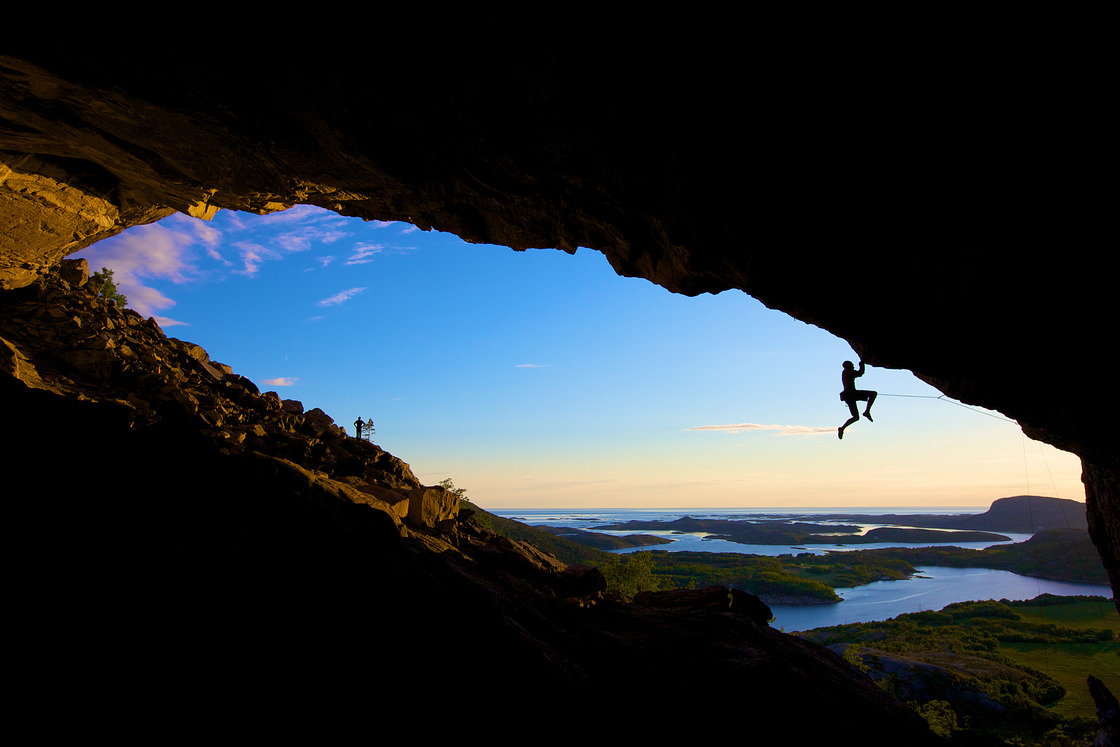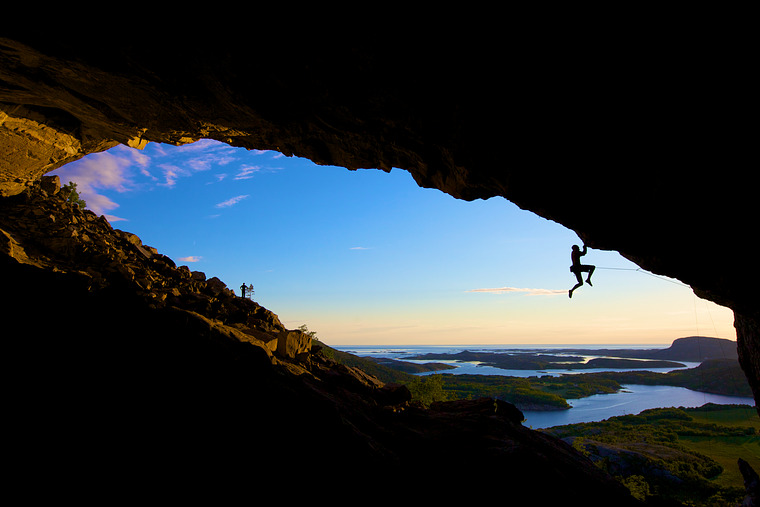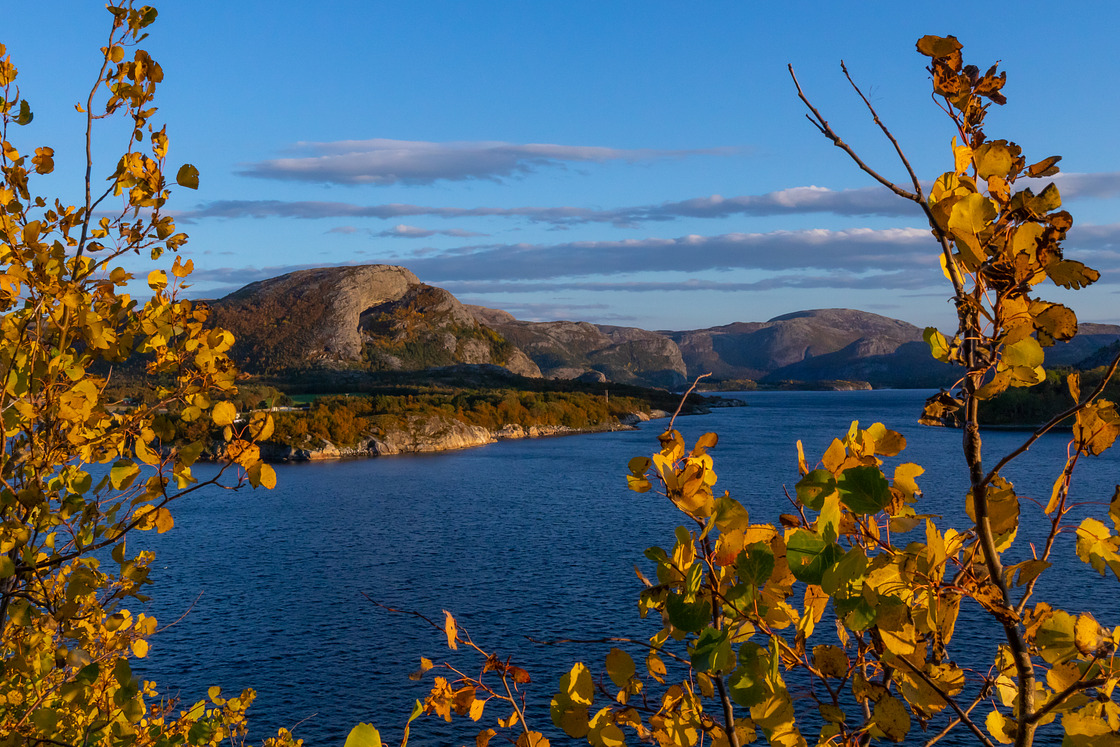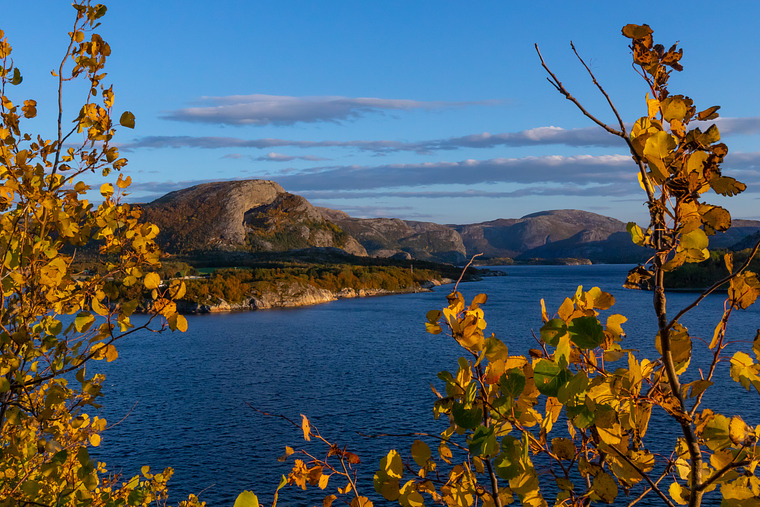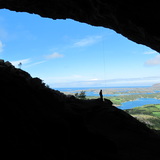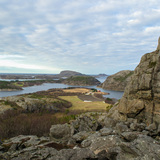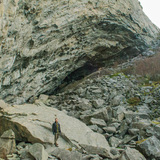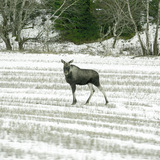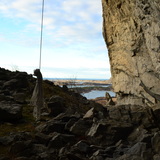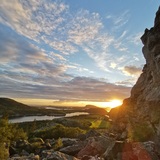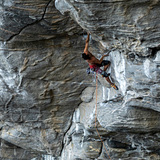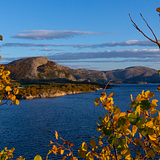The archipelago of Flatanger, located in Trøndelag, Norway, offer a truly spectacular scenery with an amazing wildlife. Home to numerous weathered world class climbing walls and caves with superb rock quality, located within fjords and on small islands. The most famous crag is undoubtedly Hanshelleren, a massive hillside cave known for many of the hardest sport climbs in the world, including the words first proposed 9b+ (Change) and 9c (Silence), first ascended by the legend Adam Ondra. The cave and its flanks, however, also houses many moderate and easy sport climbs of exceptional rock quality, making the crag a must visit for climbers at all levels with grades ranging from 4 to 9c. Notably, all routes are 100% natural, meaning no sika or chipped holds. Hanshelleren has over the past 15 years gone from being a remotely located cave with a lot of potential to one of the most famous crags in the world. Much thanks to the greatest climber of our time, Adam Ondra.
Three hours from the closest airport (Værnes), and with a resonably priced campsite (Climb Flatanger) in walking distance of the cave (as well as a multitude of other camping and housing options in the area), it is no longer as remote as it used to be. Additionally, the resent devaluation of the Norwegian currency (Krone) against Euro and Dollar has made travelling and accommodation in Norway relatively cheaper for foreigners.
High season is in the summer half of the year (April-October), making it a perfect destination for climbers seeking to find good conditions when most of Europe and the northern hemisphere is getting too hot for climbing with appropriate friction. Quick drying on the side walls of the cave, combined with a more or less rainproof cave, makes the crag climbable most of the time. In fact, some of the hardest routes are often climbed on days you normally would think staying inside is the better option.
Perfect as it may sound there is one small downside to Flatanger in summer, and that is the possibility of annoying insects. Worst on years where the spring is wet and warm they usually arrive sometime in mid june before disappearing again in early august. Depending on the year, they can be anything from barely noticeable in the evenings to a small nightmare for the belayer on cloudy windless days in early summer. Thus, as an insurance, bring your insect repellent if you come in this time period.
Rumors of giant caves and walls in Flatanger had existed for some time before climbers came to explore it in the mid90s. Interestingly, the authors of this topo even had family running the local grocery store a century ago, but no one, of course, guessed that the caves in this stunning archipelago would become a mecca for athletic high end performance in the future. The first known discovery of Flatanger’s vast climbing potential came in 1995 when four climbers, Pål Benum Reiten, Eivind Bakken, Pål Høyem, and Erik Aalde set out from the city of Trondheim to explore potential new crags in the region. They were not disappointed. Late in the evening, exhausted from hiking and climbing on smaller walls the whole day, they still drove around to look for more crags. In the dim evening light, a giant cave suddenly appeared, with dimensions hard to grasp. They subsequently drove the dirt road towards the Strøm farm to have a closer look, but with the cave somewhat hidden from the road it apparently took some convincing from the ever-enthusiastic Pål Benum Reiten to hike up and have a closer look at the cave that evening. To prevent an empty-handed return to Trondheim he brought the climbing gear with him. What met the party when they approached the cave must have been rather overwhelming. However, it didn’t stop Pål that eyed an obvious small crack at the bottom of the central cave, got his trad gear, and on-sighted, in the purest style, what became “Kakestykket” (A piece of the cake) 7a. He didn’t stop there but kept on bolting throughout the night.
Pål Benum Reiten returned to the Flatanger cave, “Hanshalleren” the following spring, the 8th of mars, with his good friend; the ever-enthusiastic Thomas Vekve. They made a good team, together with a small group of friends, for the early Hanshelleren development, with their high energy and passion for climbing. It was, however, challenging to decide how to approach bolting of new routes in this colossal temple of gneiss. Especially when recognizing that routes at that time were typically less than 30 meters long, and Hanshelleren offered the potential for routes five times that length! The steepness and height of the cave also prevented top-down bolting, so aid climbing up was really the only option. As a result, some of the early routes, like Kykkeli and Kykkelikokos, follow crack systems, and subsequently anchors, and bolts, were placed on the neighboring lines. Most of the bolted routes in this era were established on the steep wall to the left of the main cave, but they certainly saw potential for the main cave too. E.g. Pål bolted what later became Banana Ballet (8c+), first ascended by Adam Ondra. Yet, the early development of Hanshelleren was certainly hampered by the share size of the cave and a preference for climbing routes to follow an obvious line from bottom to the top of a cave or wall. Local climbers also had a penchant for bouldering and brute force and were somewhat skeptical of this lactic acid-inducing hall of gneiss. With the simultaneous discovery of several exceptionally good bouldering places in the region, holding the same superb rock quality, the focus was somewhat shifted in that direction.
The local community in Flatanger was from the beginning very welcoming to climbers, which not only facilitated the development of Hanshelleren, and other nearby crags, but also contributed to a great overall experience of travelling there. Climbers were invited in for coffee, to charge the drill for bolting, camp in barns. One story even describes how a local bought food for a climber with limited funds. We need to keep this good relationship with the friendly, local community.
After the first phase of discovery and development in the late 90`s, Hanshellerens’ left sidewall kept getting a trickle of new routes and projects into the early 2000`s, including classics such as Eventyrblanding (7c), Massih attack (8a+), and Berntsenbanden (7c). The first line inside the main cave, Dvergtrollet (8a+), was also established. However, the great potential of the steeper part of the cave was largely untouched until Runar Carlsen and Norges Boltefond (The Norwegian bolting fund) arrived at the scene with a bolting crew of rockstars in 2011. The ambitions were many, and varied from just raising the national level of routes above its previous highpoint of 8c to potentially finding the hardest route in the world. An ultimate goal was to put Norway on the map as an international climbing destination, not just known for its big walls, but also for sport climbing. To achieve these goals, a festival with a competition was planned for 2012 and a high-profile bolting crew consisting of e.g. the Spanish legend Dani Andrada, the French master Laurent Laporte, as well as Norway’s own Magnus Midtbø, got to work in the steeper part of the cave. Dani Andrada and Magnus Midtbø were also, together with Ethan Pringle, invited to compete for the first ascent of one of the newly bolted routes, Eye of Odin (8c+). Except for a few highly profiled foreign climbers, the crowd was predominantly Norwegian during the festival. Although the festival, with first ascents of many difficult new routes, undoubtedly generated some attention from media and climbers around the world, the Hanshelleren cave somewhat remained a remote cave in Norway. Albeit, some adventurous climbers, like e.g. Jorg Verhoven visited Flatanger the following spring with a notable first ascent of Nordic Flower (8c; originally graded 9a).
The paradigm shift for Hanshelleren came with one young man, the rising rock star Adam Ondra. Inspired by his cameraman Petr Pavlíček, who was introduced to the cave the previous year, they travelled to Norway just after Ondra finished high school. At the time the Lion’s share of hard routes were being put in Spain by another rock star, Chris Sharma, so it is quite remarkable that Ondra decided to travel to Flatanger and Norway. The destination was certainly off the radar. Upon his arrival Ondra made extremely quick work in repeating the established routes, on-sighting all of them, before proceeding to make the first ascent of a project bolted by Midtbø the year before. He made quick work of that project too, and it is today known as Thors Hammer (9a). Ondra obviously needed a more difficult challenge. Perhaps even a project that could change climbers’ perception of what was possible to climb. His eyes fell on an unbolted line with what appeared to be a brutal start. Later the same year he succeeded in climbing it. The world’s first proposed 9b+, Change. With the ascent of what could be the hardest route on the planet, Flatanger and Hanshelleren rocketed into climbing crags’ hall of fame. Since then, most of the remaining lines and extensions have been bolted, many of them by Ondra. In 2017 he once again proposed a new level for hard sport climbing, with an ascent of Silence (9c) in the main cave. Today, the cave may have the highest concentration of hard routes in the world.
Unfortunately, the interest and attention of climbing in the cave has caused some turmoil with some of the landowners. Resulting in a temporary ban of bolting. As we rely on the goodwill of the landowners to continue climbing in this amazing area, we strongly encourage everyone that visits the cave to respect their wish and leave the drill at home. Please also park in designated areas, throw your thrash in the bin, use the designated toilet in the cave, and follow marked paths and roads.
